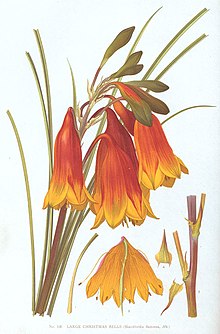bio.wikisort.org - Plant
Blandfordia, commonly known as Christmas bells,[4] is a genus of four species of flowering plants native to eastern Australia. Christmas bells are tufted, perennial herbs with narrow, linear leaves and up to twenty large, drooping, cylindrical or bell-shaped flowers.
| Christmas bells | |
|---|---|
 | |
| Illustration of Blandfordia grandiflora by Edward Minchen[1] | |
| Scientific classification | |
| Kingdom: | Plantae |
| Clade: | Tracheophytes |
| Clade: | Angiosperms |
| Clade: | Monocots |
| Order: | Asparagales |
| Family: | Blandfordiaceae R.Dahlgren & Clifford[2] |
| Genus: | Blandfordia Sm.[3] |
 | |
| Distribution | |
Description
Plants in the genus Blandfordia are tufted, perennial herbaceous monocots with fleshy, fibrous or tuber-like roots from a corm. The leaves are narrow linear, usually crowded in two ranks from the base of the flowering stem. Up to twenty flowers are arranged near the top of the flowering stem that has small, leaf-like bracts. The flowers are usually red with yellow lobes. The sepals and petals are fused to form a tube-shaped, cylindrical or bell-shaped flower with six lobes about one-fifth the length of the tube. There are six stamens fused to the inside wall of the flower tube and the style is linear. Flowering occurs in spring or summer and is followed by the fruit which is a capsule, tapered at both ends and containing a large number of hairy brown seeds.[5]
Taxonomy and naming
The genus Blandfordia was first formally described in 1804 by James Edward Smith from dried specimens sent from Sydney by the colonial surgeon, John White. Smith published the description in Exotic Botany. The name Blandfordia honours George Spencer-Churchill, 5th Duke of Marlborough, the Marquis of Blandford. The type species is Blandfordia nobilis as it was the first described by Smith.[3][6][7][8]
Blandfordia placed in the family Blandfordiaceae of the order Asparagales of the monocots.[2] It is the sole genus in the family Blandfordiaceae. Such a family has only recently been recognized by taxonomists. The APG IV system of 2016 (unchanged from the 1998, 2003 and 2009 versions) recognizes this family.[2][9] Previously various families were suggested.[10]
Four species of are accepted by the World Checklist of Selected Plant Families:[3]
- Blandfordia cunninghamii Lindl. (New South Wales)
- Blandfordia grandiflora R.Br. (Queensland, New South Wales)
- Blandfordia nobilis Sm. (New South Wales)
- Blandfordia punicea (Labill.) Sweet (Tasmania)
Distribution and habitat
Two of the four species of Blandfordia are restricted to New South Wales, a third also occurs in Queensland, and the fourth only occurs in Tasmania. Christmas bells usually grow in heathlands, especially waterlogged sites and mostly in coastal or near-coastal areas although some populations occur on the tablelands.[10]
Use in horticulture
The large, distinctive flowers and long vase life of Blandfordia suggest good commercial potential for the cut flower trade and a small group of producers cater to the domestic and export markets. It is a protected species and in the past over-collecting has caused localised extinction and damage to the habitat of the species.[4]
References
- Maiden, Joseph (1895–1898). The flowering plants and ferns of New South Wales (Part 5). Government Printer, Sydney. Retrieved 20 January 2019.
- Angiosperm Phylogeny Group (October 2009). "An update of the Angiosperm Phylogeny Group classification for the orders and families of flowering plants: APG III". Botanical Journal of the Linnean Society. 161 (2): 105–121. doi:10.1111/j.1095-8339.2009.00996.x.
{{cite journal}}: CS1 maint: uses authors parameter (link) - "Blandfordia". World Checklist of Selected Plant Families (WCSP). Royal Botanic Gardens, Kew.
- Gollnow, Bettina; Dick, Gordon; Dalley, Paul. "Growing Blandfordia (Christmas bells) commercially" (PDF). New South Wales Department of Agriculture. Retrieved 19 January 2019.
- Quirico, Anna-Louise. "Blandfordia". Royal Botanic Garden Sydney. Retrieved 19 January 2019.
- "Blandfordia". APNI. Retrieved 4 December 2018.
- Cavanagh, Tony. "Blandfordia in history". Australian Native Plants Society (Australia). Retrieved 19 January 2019.
- Smith, James Edward (1804). Exotic Botany (Volume 1). London: R. Taylor & Co. pp. 5–6. Retrieved 19 January 2019.
- Angiosperm Phylogeny Group (May 2016). "An update of the Angiosperm Phylogeny Group classification for the orders and families of flowering plants: APG IV". Botanical Journal of the Linnean Society. 181 (1): 1–20. doi:10.1111/boj.12385.
{{cite journal}}: CS1 maint: uses authors parameter (link) - Klaus Kubitzki, Herbert Huber (Prof. rer. nat.) (1998). Flowering plants, Monocotyledons: Lilianae (except Orchidaceae). Springer. p. 150. ISBN 978-3-540-64060-8.
External links
- "Blandfordia Sm". Atlas of Living Australia.
На других языках
- [en] Blandfordia
[es] Blandfordia
Blandfordia es un género de fanerógamas (plantas con flor) nativas del este de Australia. Se las llama comúnmente Christmas Bells debido a la forma de sus flores y el momento de la estación de floración austral en el verano de Australia. Blandfordia es el único género de la familia Blandfordiaceae, y lleva el nombre que el botánico inglés James Edward Smith le puso en 1804 en honor de George Spencer Churchill, Marqués de Blandford.[ru] Блендфордия
Блендфордия (Blandfordia) — род цветковых растений, выделяемый в семейство блендфордиевые (Blandfordiaceae), относящееся к порядку спаржецветные. Распространен на востоке Австралии. Виды этого рода также называют рождественскими колокольчиками из-за характерной формы цветка и сроков цветения. Род был назван английским ботаником Джеймсом Эдвардом Смитом в 1804 году в честь Джорджа Спенсера-Черчилля, пятого герцога Мальборо, маркиза Бленфорда.Другой контент может иметь иную лицензию. Перед использованием материалов сайта WikiSort.org внимательно изучите правила лицензирования конкретных элементов наполнения сайта.
WikiSort.org - проект по пересортировке и дополнению контента Википедии